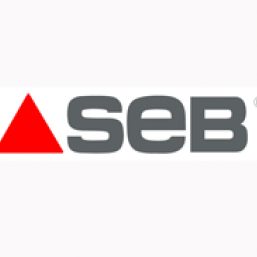
Groupe SEB relies on VISEO to implement SAP Business One
The world’s largest manufacturer of small household appliances and cookware continues to expand its global business footprint. When it comes to integrating new subsidiaries and reinforcing its leadership, Groupe SEB relies on the SAP® Business One application for fast results at low cost rates. For many of the group’s independent subsidiaries and from a business and apllicative point of view, SAP Business One serves as a light and agile alternative to SAP ECC software, used at the company headquarters and larger subsidiaries.
Every second, six products manufactured by Groupe SEB are sold in the world’s markets. The company’s portfolio of brands includes key brands such as SEB, Tefal, Rowenta, Moulinex, Krups, All-Clad, and Lagostina. The products made by Groupe SEB range from domestic appliances such as blenders, toasters, and hair dryers to top-of-the-range cookware for discerning connoisseurs. On average, Groupe SEB adds some 200 new products to its portfolio each year.
Growth Fueled by Acquisitions
Acquisitions have played an important role in Groupe SEB’s expansion. In 2005 the group began investigating the best way to integrate the business processes of newly acquired subsidiaries. One of the options considered was rolling out SAP ECC at each new business unit. “SAP R/3 had proved its worth for us here at headquarters as well as in large subsidiaries in a number of countries.
For smaller subsidiaries and business units, particularly in emerging markets, we wanted a ‘lighter’ solution that would cost less and be easier to deploy,” notes Benoît Champouillon, business units and continents relationship manager for Groupe SEB.
So the IT organization at Groupe SEB went looking for the ideal solution. IT staff visited an international cosmetics manufacturer that faced similar challenges. “We wanted to support smaller business units within Groupe SEB using a single application for consistent key business processes such as logistics, supply chain management, and financial reporting. Of the alternatives we evaluated, SAP Business One was the best fit for our requirements. SAP Business One is the perfect complement to our SAP ECC software for our smaller business units. Also, the international footprint of SAP ensures that SAP is present wherever Groupe SEB does business,” explains Champouillon.
Integration and Transparency
“Another point in favor of SAP Business One is that it’s easy to implement in our SAP R/3 software landscape,” explains Antoine Ravier, worldwide SAP Business One project manager for Groupe SEB. “We configured a standardized template for SAP Business One that lets our smaller business units quickly roll out their business processes. This approach ensures business process consistency across the group and allows us to share resources and skills to keep down costs.”
Groupe SEB turned to VISEO, a systems integrator, for an integration module tailored to the needs of the group’s distributed international operations. Smoothly linking SAP Business One with SAP ECC or the SAP NetWeaver® Business Warehouse component, this module enabled Groupe SEB to implement three main key processes: product data sharing, supply chain management, and financial reporting. Following this process, Groupe SEB implemented its first integration of SAP Business One for its subsidiary in Japan. The group’s Korean subsidiary soon followed.
Groupe SEB now has 420 SAP Business One users in 13 of its subsidiaries. Some 3,400 of the group’s employees use SAP ECC. For all of the Groupe SEB subsidiaries, first-level support for SAP software is provided locally, while second-level support is provided centrally from the group’s headquarters in France. “SAP Business One provides an intuitive user interface that is available in a number of local languages, including Korean and Japanese. What’s more, it supports local legal compliance, including tax regulations, in each country. And thanks to the integration with the corporate applications including SAP R/3, Groupe SEB can count on data consistency and transparency in spite of the complexities of our groupwide business model,” adds Ravier.
The Right Application Fit
In recent years, the IT organization at Groupe SEB has successfully completed a number of business network integration projects. Some of these projects used SAP Business One, while others involved SAP R/3. Based on its experience, Groupe SEB has established a decision-support matrix to determine the “right” application for a subsidiary. The IT organization assesses each new subsidiary’s specific business process requirements – rather than its size or location. If a new subsidiary or business unit runs all of its business processes in-house and can handle its back-office functions without external support, SAP Business One is the best choice. In subsidiaries where financial management or supply chain management may call for external support, SAP R/3 is used, with a regional back office to provide the required business process support.
For example, in its new subsidiary in Switzerland, Groupe SEB implemented SAP R/3 because local needs required back-office functions provided by the group’s hub in Germany. The four manufacturing subsidiaries recently acquired by Groupe SEB in China also rely on SAP R/3. In Thailand, on the other hand, Groupe SEB chose SAP Business One for the local subsidiary because all its business processes, including logistics, are handled at the local level and no remote back-office support is required.
Ease of Deployment
Today, Groupe SEB can integrate a new subsidiary within a few months. For its recently established business unit in Peru, the group’s IT organization helped to set up the country-specific business tasks and preconfigured the integration with groupwide processes in SAP Business One. Completed in three months, the project included the full rollout of SAP Business One at the Peruvian subsidiary. The same approach has helped ensure the smooth integration of the group’s new business operations in Argentina and Chile. “Using a common language across our business application landscape and having real-time insight into business activities provide key advantages in our highly price-sensitive market,” notes Champouillon.
Aligned with Corporate Strategy Goals
The long-term business strategy of Groupe SEB is governed by four priorities: geographic leadership, product leadership, competitive edge, and responsiveness to retailers. Thanks to the integration of the group’s SAP Business One installations with SAP R/3, Groupe SEB has a common application platform in place that is shared by most of its member companies. This platform helps ensure centralized control at corporate headquarters in real time while granting subsidiaries a considerable amount of autonomy, including local business logic. Aligned with corporate strategy goals, this approach supports Groupe SEB as it continues to extend its global business reach through acquisitions.
Check our other Success Stories:







